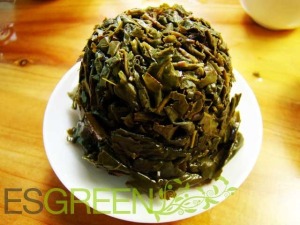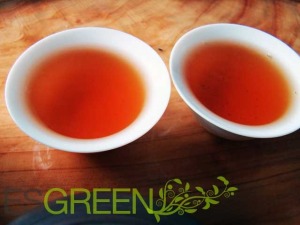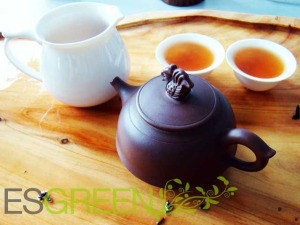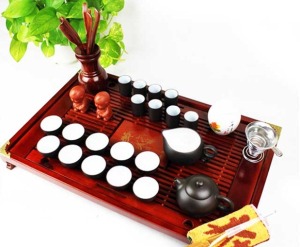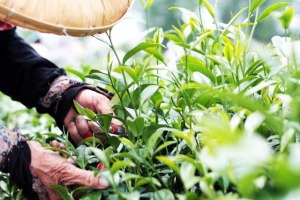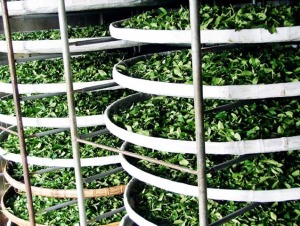Tie Guan Yin
Member of the TOP 10 Chinese tea!
General Introduction
This is probably the most famous of all Chinese Oolong teas.
Tie Guan Yin is the most famous tea bush in Anxi City, which lies in Fujian Province. “Tie” meaning "iron", refers to density of this tightly twisted tea or its dark oxidized color. It is a common Chinese habit to describe heavy objects with this term "Guan Yin" is the name of the Buddhist bodhisattva of compassion. Also known as the "Iron Goddess of Mercy" and the tea is as magnificent as its name implies.
There are many legends surrounding the origin of its name and one of it tells the story of a kind-hearted but poor farmer named Wei Yin.
Despite working hard every day to make a living, Wei Yin would spend his free time tending an abandoned Guan Yin (Goddess of Mercy) temple he found near his place.
One day, he fell asleep in the temple and dreamed about the Goddess telling him to look for a cave behind the temple.
There, he found a single tea shoot where he took home and planted it in an iron pot. Slowly, it grew into a tea bush with exceptional quality tea leaves.
Wei then gave cuttings to his neighbors and friends to grow. The County soon prospered due to the popularity of the tea.
Tie Guan Yin can now be found in the menu of most Chinese restaurants throughout the world.
Other names:
Ti Kwan Yin, Anxi Tie Guan Yin, Iron Goddess of Mercy
Origin:
An Xi, Fujian Province of China
Processing
Tea grown at organic garden appears to be less active and less productivity as tea gets less nutrition and pesticide as compared to the ordinary tea garden. As the identical characteristics, tea leaf turns into yellow color and sweetness in flavor and taste is outstanding.
Plucking is carried out by hand. 3 to 4 leaves including a bud is carefully plucked by hand. Plucking is carried out in Spring, Summer, Autumn and Winter. The best quality is produced either from Spring or Winter.
Sunshine Withering
After plucking, tea leaves are spread over the ground under the natural sunshine. It is called Sunshine Withering. Usually clouded weather is ideal to grow this tea in order to avoid excess damage on tea leaves. If the sunny weather continues, a black cloth is used to cover the tea leaves to block out the harsh rays of sunshine. With sunshine withering, moisture inside the tea leaf gets evaporated and fermentation is moderately triggered. The tea leaf will gradually start releasing a refreshing aroma.
Indoor Withering
The method of fermentation for oolong tea is completely different from that of black tea. After the sunshine withering is completed, tea leaves are conveyed into the factory and spread over a sheet. If tea leaves are rich in moisture, they are spread into a thin layer in order to increase the evaporation process. The tea leaves are then tossed onto a bamboo tray. This agitation and tossing, causes friction which in turn causes the tea leaves to start fermentation. The tray is then placed on a rack and these processes are repeated over and over again. This is what is called fermentation. Tea leaves gets oxidation mediated by the oxidation enzyme when the tea leaves get bruised.
Once entering the fermentation room, you might get surprised with its fragrance. You feel as if you are in a flower garden. Subsequently tea leaves are rotated in a bamboo drum. The tea leaves are lifted and dropped several times. Gradually the edge of tea leaves get damaged and further fermentation takes place. Tea leaves are again spread over the bamboo tray and the same process is repeated over and over again.
Once tea leaves get sufficient fermentation, it starts generating a flowery fragrance. Tea that is processed by a fine tea master is easily distinguishable. The original shape is maintained without any damage done to the tea leaves and only the edge of tea leaves are found to be red in color. This indicates that the tea leaves were successfully semi-fermented and the quality is far different from the tea leaves which have a reddish appearance at the center part of the leaf. Once the tea master finds that fermentation is sufficiently achieved, the tea is then sent for heat treatment in order to arrest further fermentation process. If this is not carried out swiftly, the tea leaves will keep on fermenting and it will finally turn into black tea.
The number of rotation and timing of fermentation is judged based on the moisture content, flavor and color. This decision requires top-notch experienced tea technicians which affects the quality of tea tremendously. All technicians follow the instruction of a tea master. In order to get good quality tea, we need to pick out an excellent tea master.
Rolling
At this stage, tea is fermented and giving an identical character of Tie Guan Yin Oolong. However tea leave has not been damaged or bruised except for its edge. Without physical damage on tea leaf, it is difficult to "brew". On the other hand, conducting the rolling process as black tea that tea leaf is twisted tautly under the strong pressure, tea leaf will be over damaged and get astringent and harsh in taste. In addition, excessive damage of leaf will expose constituent to the oxygen and cause unwanted oxidation that will also affect to the taste and flavor. Therefore the very unique rolling process called "Bag rolling" is used for oolong tea. Literary tea leaf is wrapped in cloth and rolled. Therefore, tea leaves are twisted just right with the right amount of pressure applied.
While the tea leaves are still warm and soft, it is quickly wrapped in cloth bag. About 10-20kg of tea leaf is wrapped and it is made into the size of about a basket ball. Then the end of cloth is mechanically twisted by machine in order to squeeze it into a very solid ball. Finally it becomes as solid as a stone ball and as a result the tea leaves are compressed very tightly.
Then, the cloth ball is clamped between disks at the top and bottom. The top disk does not move while the bottom disk rotate and tea gets further pressure through the motion. After the rolling process is conducted for a while, the bag is opened and the tea leaves are taken out and reheated again in a rotating drum. This is necessary as once the tea leaves cool down, it becomes crispy and easily crushed. This series of processes are repeated several times until it is well rolled.
The tea leaves are gradually tighten and become round in shape. High grade tea is usually very solid and it appears to be dark and shiny as the juice of the tea leaf is squeezed and hardens on the surface of the leaf.
The same sequence is repeated over and over again. The parameter is varied depending on the condition of leaf such as moisture content. It is important to feel the condition of tea leaf and apply the suitable method of process which is judge expertly by the tea master.
After this rolling process is completed, the tea leaves are dried and this will reduce the moisture content down to 5%.
Grade & Inspection
Although oolong tea made from Tie Guan Yin tea bushes has long been popular, the style in which it is produced has changed considerably over the years.
With the introduction of Taiwanese processing techniques in the mid 1990s and rising popularity of lighter roasted and less oxidized teas during this decade, the finished leaf of Tie Guan Yin has shifted in appearance from dark brown, flat and leafy to light green and tightly rolled.
Taste:
It is not bitter, but sweet. It is surprisingly economical as you can brew more than 6 times.
Customers who have tried our tea have told us that they were surprised for the tender, yet strong flowery aroma.
In addition, it gives a very mellow and thick taste with a sweet after taste.
Appearance:
Tightly rolled jade green leaves.
When steeped in boiling water the crinkly balls unfurl, revealing green-brown, lace-edged leaves.
The infusion is yellowish in color.
Health Benefits
In recent years, the study by scientists at home and abroad that Japan is particularly scientists confirmed Tieguanyin the chemical composition and mineral elements on human health has a special function, generally in the following areas:
1. Tieguanyin the anti-aging effects
Some Chinese and foreign scientific research shows that people do not aging and in vivo oxidation of unsaturated fatty acids over the role without excessive oxidation of unsaturated fatty acids is related to the role of free radicals. High chemical activity of free radicals will not excessive oxidation of unsaturated fatty acids, cell function mutation or a recession, caused proliferation and necrosis caused a person to be put to death disease. Excessive lipid oxidation is the demon human health, but the chief culprit is free radicals, as long as the free radical scavenging swap, it can be normal cell growth and good health and longevity.
Usually, there are commonly used antioxidants vitamin C, vitamin E, which can effectively prevent excessive oxidation of unsaturated fatty acids. Recently, Japanese researchers showed that the Tieguanyin polyphenols can prevent excessive oxidation; purine alkaloids, indirectly play a role in scavenging free radicals, so as to achieve the purpose of aging.
2. Tieguanyin anti-cancer role
Cancer is a serious threat to people’s health in today’s "incurable." Therefore, the tea cancer research in recent years has aroused people’s great interest and concern. A few years ago, there have been reports that a Shanghai tea to the public because of esophageal cancer reduced year by year, this tea can prevent the occurrence of cancer in the world this fact has aroused great repercussion. Now tea can prevent cancer cancer has been recognized by the world, and in tea anti-cancer effects in cancer prevention is the best Tieguanyin.
As early as 1983, Japan Okayama University Okuda extension of the male professor had several dozens of plants polyphenolic compounds for screening anticancer effect change, results show that: catechins (EGCG) has a strong anti-cancer Activity. Other scientists confirmed Tieguanyin-variation of the study, Tieguanyin tea polyphenols that this role is the main active ingredient in the carcinogenic chemicals in the study, and affirmed the Tieguanyin tea polyphenols role in the prevention of cancer . In addition, Tieguanyin of vitamin C and vitamin E can prevent carcinogens – Synthesis of nitrosamines, the prevention and treatment of cancer have a greater role.
3. Tieguanyin role in the anti-atherogenic
May 31, 1999, in Tokyo, Japan held the fourth oolong tea and health seminar, the Fujian Provincial Traditional Chinese Medicine Institute Ling, vice president of the reports they had 25 hyperlipidemia obesity targets for clinical observation, Tieguanyin tea consumption on the blood inhibit the oxidation of low-density lipoprotein in the blood and improve the role of lipid metabolism. Studies have shown that the Tieguanyin tea polyphenols compounds and vitamins in the blood can inhibit LDL oxidation. Japan Mitsui Institute of Agriculture and Forestry Dr. Masahiko in the years of research has also confirmed that tea polyphenols compounds not only can lower blood cholesterol, but also significantly improved high-density lipoprotein in the blood and the ratio of low-density lipoprotein. Caffeine can diastolic blood vessels, speed up the breathing and blood lipid lowering, the prevention and treatment of coronary heart disease, hypertension, atherosclerosis and other cardiovascular and cerebrovascular diseases have a certain role.
According to the Fujian Medical University Coronary Heart Disease Study Group in 1974 in Fujian Anxi Chaxiang the 1080 survey found that farmers do not drink Tieguanyin tea incidence rate of 3.1% for the occasional drink 2.3%; perennial drinking (3 years above) at 1.4%. Evidently, Changhe Tieguanyin people do not drink Tieguanyin than the low incidence of coronary heart disease.
4. Tieguanyin the role Qingre downbear fire
Tea drinks is a good summer cooling purposes. Li Shizhen "Compendium of Materia Medica" contains: "tea bitter cold, most downbear fire, the fire was riddled with fire down the supernatant.Morning drink was dropped due to fire, heat and hot drinks, or by Powder. "in the dog days of midsummer, when the cool air, and Shu Qi pressing, drink a glass of cool, or hot cup of Tieguanyin Tieguanyin will feel physically and mentally cool, Sheng Jin Jieshu. This is because the type of tea polyphenols contained in tea, sugar, amino acids, pectin, vitamins, and other saliva from the mouth of a chemical reaction, moisten the mouth, it can play the role of Shengjinzhenghe. At the same time, Tieguanyin of caffeine role in bringing a lot of energy from the skin pores in the human body falling apart. According to reports, a cup of hot tea, the human body through skin pores sweating dissemination of calories, the equivalent of this cup of tea 50 times, it can feel cool Jieshu.
5. Tieguanyin the refreshing benefits Reith role
Think tea can benefit almost everyone knows refreshing. Medical Books documented many of China’s ancient dynasties Wenrenmeike, all monks also waved Shenghuamiaobi, Chung tea refreshing benefits of reactive thinking. Bai Juyi "gifts east-13" poem said: "Collaboration floor, Kaijin Takeshita wind. Flooding worries that Jiuli, broken sleep see tea reactive." The poem that referred to the tea break refreshing sleep of the work. Su Shi said: "Better tea 30, how to taste without trial, Feng Bao gifts Lay, Nebuta Cengfang war." He said gave the packet tea Lay built, so drink in Canshan can avoid dozing. Think tea can be beneficial, so loved by people, especially for some writers, poets and other intellectuals beloved. If the French writer Balzac, the Chinese-American writer Han pitch Taoxueken famous Chinese writer, and so fond of tea to help Evans.
Tieguanyin benefits can be refreshing thought, its principal functions is the caffeine in tea. Caffeine is the central nervous excitement, the promotion of thinking, improve efficiency function. Therefore, after the tea break sleeping, refreshing to trouble lifting tired, sober-minded, enhance thinking, can significantly improve the ability of oral and mathematical thinking response. At the same time, Tieguanyin contains polyphenolic compounds, offset by a pure caffeine on the adverse effect of the human body. This is also a long history of tea drinking and inspiring, and the continuous development of one of the important reasons.
6. Tieguanyin control diabetes
Diabetes is a worldwide disease. At present, there are about 200 million people around the world suffering from diabetes, China has more than 30 million people are suffering from diabetes. Diabetes is a metabolic disorder mainly sugar systemic chronic disease. Typical clinical manifestations as "a little more than 3", that is, more drinking, more urine, and more fresh and emaciated, weak body. Chinese disease "Diabetes," and its coke hot and humid areas. The disease is the main reason for the lack of polyphenols in substances, such as vitamin B1, pantothenic acid, phosphoric acid, methyl salicylate, and other components, so that obstacles in glucose metabolism, increase in blood glucose levels, metabolism decreased.
Japan M.D. Ogawa Goshichiro clinical trials, and others confirmed that regular tea drinking can be timely replenishment of the body of vitamin B1, pantothenic acid, phosphoric acid, methyl salicylate and polyphenols, can prevent the occurrence of diabetes. For patients with moderate and mild diabetes can blood sugar, urine sugar reduced to a few, or completely normal for severely diabetic patients, enabling blood sugar, urine sugar decreased, the main symptoms relieved.
7. Tieguanyin role in the slimming aerobics
Obesity is a rising standard of living with people and the malnutrition of the disease, it is due to excessive intake of nutrients in the storage or use of the energy caused by inadequate. Obesity not only to their daily lives in the cause much inconvenience, but also cause cardiovascular disease, diabetes mellitus and one of the reasons why.
1996, Fujian Institute of Chinese Medicine of 102 adults suffering from obesity, men and women, the role of diet drink Tieguanyin research. Research shows that Tieguanyin contains large amounts of tea polyphenols substances can not only enhance the role of lipolysis, and organizations can promote the metabolism neutral lipase activities. Thus can improve drinking Tieguanyin obesity physique, effective in reducing obesity subcutaneous fat and waist circumference, so as to reduce its weight.
Quanzhou in Fujian Province People’s Hospital by Tieguanyin slimming tea on 164 people suffering from obesity treatment slimming tea served daily from 12 to 14 g, 15 days for a course of treatment. After two courses of observation, patients with serum lipids, triglycerides and cholesterol has decreased significantly, weight also will be reduced, the total efficiency of the treatment of more than 70 percent.
8. Tieguanyin the role of dental caries
It is generally considered a danger to the two dental disease, first caries, and the second is periodontitis. Dental caries, commonly known as tooth decay, dental common multiple. Dental caries in many causes, one of the important reasons are: poor dental calcification, not enough hard texture and can easily be damaged. Tea can protect teeth, has been in the application of ancient China. Song Su in the "tea" Zhongyun: "tea mouthwash, both to trouble greasy, but also Kennedy teeth, absorbing and marine." Modern scientific analysis, Tieguanyin contains a wealth of fluoride, and general Few of fluoride in food. Tieguanyin Fluoride in about 40% to 80% dissolved in water, vulnerable and in the teeth of the combination of calcium in teeth formed on the surface of a layer of calcium fluoride and played anti-acid anti-caries effect.
Japan in two adjacent villages on the enrolment rate of children’s dental caries done survey results show that drinking Tieguanyin the prevention and treatment of dental caries have good results. Each day children enrolled in a cup of Tieguanyin by 0.4 milligrams of fluoride, the last one year, the original of children suffering from dental caries in half recovery. Japan has 100 statistics suffering from dental caries in the primary school students, and economic reform after drinking Tieguanyin, including 55 percent of students suffering from dental caries disease reduced significantly. Thus, the drinking Tieguanyin of people without dental caries preventive effect on the people who have dental caries have a therapeutic effect.
9. Tieguanyin bactericidal effect Zhilishen
Anxi already used in the civil Tieguanyin dysentery and stomach pain treatment practices. Ancient Chinese medical books in a lot of tea to treat bacterial dysentery, dysentery, white diarrhea, acute enteritis, acute gastritis records. Tieguanyin Why can play a role Zhilishen sterilization? TP is the main compound. As tea polyphenols into the gastrointestinal tract, can intestinal function relaxation of tension, easing intestinal movement at the same time, it also enabled intestinal protein coagulation, because the bacterial protein itself is constituted by the TP and bacterial protein After the meeting, which will bacterial death, played a role in the protection of the gastrointestinal mucosa, it is the effectiveness of the treatment enteritis.
10. Tieguanyin the enemy Hot Smoke
Hot tea can be the enemy of tobacco, this is a fact known to all. Acting out of Jurists Wang Yangming "As Hanzui, has to be Hot tea", once that the people of our country have long recognized that the effectiveness of anti tea. The ancients often "pouring liquor unhappy," "Hot tea." Tang dynasty poet Liu Yuxi, one day drunk wine, Bai Juyi reminded of the "six tea" can dealcoholic, it satisfactory delivery of sobering-up for tea, tea for the future generations-story thing. Liquor is the main component of alcohol, a glass of wine contains 10% to 70% alcohol. The Tieguanyin tea and ethanol (alcohol in the main components) offsetting each other, it can dealcoholic tea.
Tieguanyin not only sobering-up, and the enemy can smoke. As Tieguanyin containing a phenolic acids substances can precipitate the nicotine in tobacco, from the in vitro. At the same time, Tieguanyin of caffeine can increase liver drug metabolism, and promote blood circulation, the body of nicotine in the blood away from the urine excretion, reduce and eliminate the side-effects of nicotine. Of course, such a role is not just caffeine effectiveness of a single, but with tea polyphenols, vitamin C and other ingredients synergy results.
Appendix: Tieguanyin effectiveness of the reports
June 15, 1989 "health" report, entitled "Chang Yin Qing-Cha can be anti-cancer": "Tea in vivo tumor suppressor test recently by the Chinese Academy of Preventive Medicine, Nutrition and Food Hygiene Research Institute. This this is the first time both at home and abroad. presiding over this trial is that the chemical and toxicological by an associate researcher at the Korea Research Chi and her assistant Xu Yong. them to feed rats such as Fujian five Tieguanyin tea while providing artificial Synthesis of the purity of more than 99.8 percent of the carcinogenic methylkji nitrosamines. after three months, the rats fed tea incidence of esophageal cancer is 42% to 67% of the average number of mice of cancer for 2.2-3 , while rats fed tea esophageal cancer rate was 90 per cent, the number of cancer for an average of 5.2. five tumor suppressor effect of tea to Fujian Tieguanyin and Fujian scented tea is the best, Hangzhou, green tea, black tea and green tea in Hainan times. "
"Chinese tea" are: "the most prominent, the most famous quality products – Tieguanyin, ring, the famous global oolong tea with foreign countries in recent years widely rumored that the anticancer effect is mainly Tieguanyin. Thus set off ‘ Oolong tea hot ‘, especially Japan import large quantities of Tieguanyin, from the Chinese medicine sector attention at home and abroad, have pharmacological research and clinical trials. Tieguanyin is not only superior in quality, and have adequate fitness category than the son of tea polyphenols than Other tea superior efficacy of the anticancer Cellulite, in the tea could be a king. this is the country’s leading products, are universally acclaimed at home and abroad. "
"Chinese tea" are: "1977, the Medical University in Japan Cihui village governance-Dr, after clinical trials found that regular tea drinking Tieguanyin China can effectively reduce cholesterol in patients with obesity and weight. Thus creating enormous interest, began to Tieguanyin tea called ‘slimming tea’, ‘Beauty tea’, ‘longevity tea’. tea Japan Research Centre, Dr A Nan Fung is the Tieguanyin tea study concluded that: Oolong tea Rail concept Music to the prevention of atherosclerosis and normal cells inhibited significantly the role of mutation. Therefore, the Japanese people are extremely welcome. " 1998, Fujian Institute of Chinese Medicine in the infirmary with Tieguanyin nine men were members of convalescence serum and urine of vitamin C content Experiment: "The results show that drinking Tieguanyin, loads of vitamin C in the body, maintain all Blood concentrations of vitamin C decreased, while reducing the total vitamin C urine output. Tieguanyin when to stop drinking, vitamin C urine output rise very fast.mm Tieguanyin polyphenols substances on the human body to retain vitamin C content synergy , will be able to improve the body’s metabolism. "
How to Brew
1. Arrange tea ware.
2. Pour boiling water into the tea pot and fill up to 70%. This is to heat up the tea pot.
3. After 20 seconds, remove hot water from the warmed tea pot.
4. Usually 1g is equivalent to 25-50ml of water. For the small tea pot for 1 to 2 persons, 3-4g is sufficient.
5. The tea pot in the photo is about 200ml and therefore we take tea leaf around 5g.
6. Pour boiling water onto tea leaf up to 50% of the volume of tea pot. It is not for washing purpose, but to heat up the tea leaf and open them up.
7. Once again pours off hot water within 10 seconds. Usually we recommend 7 seconds.
8. Pour boiling water into tea pot up to 90%.
9. You can feel the aroma through the upcoming steam.
10. Gently place the lid and leave it for 55 seconds. For second brewing leave it for 45 seconds, follow by 55 seconds for the third brewing.
11. In China, they pour boiling water over the cap in order to keep the tea pot warm. But this method never used in Taiwan as they think tea pot is hot enough.
12. While waiting for brewing, pour hot water from pitcher into the tea cups in order to warm them up. But this is not practiced in Taiwan as they believe there is no need to warm up the tea cup.
13. Pour tea into pitcher completely. It is important to enjoy the following brewing.
14. Pour tea from the right end which is supposed to be served for the guest. The last one is meant for the host.
Click Here to Take a Peek at a Traditional Oolong Tea Ceremony…
How to Store
The higher the tea quality, the more easily it loses its flavor.
Put some effort and it should keep fresh for a longer time.
Keep tea away from moisture
Once a bag of tea is opened, please finish it within 3 months if you wish to enjoy its freshness.
From the medical point of view, it is safe to consume the tea even if it is kept for a few years.
However the freshness disappears if it is kept for too long.
Tea must be tightly sealed before it is kept.
Tea should be kept in ambient and dry conditions such as in the living room, but it must be completely away from humidity.
Tea should not be kept in the kitchen as the environment is very humid.
Avoid enclosed area such as inside the cupboard or drawer as these places are damp.
Also avoid opening the bag of tea in humid atmosphere.
It is recommended to open the bag during a sunny day or under air-conditioned atmosphere.
Once tea leaves absorb moisture, deterioration of tea will be triggered within a few days.
Tea will then give an astringent taste, sometime it tastes sour. The fresh aroma also becomes weaker.
Beware of keeping the tea in the fridge
If the tea is sealed, keep in a freezer. Cover with a box to insulate from temperature change.
Once the package has been opened, store away from light, moisture, smell and heat in an airtight container.
The quality of tea lasts longer if it is kept in the fridge. However we strongly recommend you not to keep tea in the fridge.
When tea is withdrawn from the fridge, there is usually condensation. Once tea is exposed to moisture during condensation, the quality will deteriorate within a few days. The higher moisture content in the tea leaves will trigger oxidation and it will completely destroy the quality of tea.
Here’s one frequently asked question:
What happens if bag is sealed using tape or tea is packed in zipper bag and kept inside the fridge?
For your information, these simple sealing methods are not sufficient. When the bag is withdrawn from the fridge, it is cold inside the bag and therefore causes negative pressure.
Air will be drawn from outside and condensation will occur.
In addition, if the bag is taken in and out from the fridge very often, this will cause heat stress to the tea leaves as temperature is increased and decreased very frequently.
If tea is kept in the fridge, when it is withdrawn from the fridge, it is necessary to leave it in ambient atmosphere for more than 24 hours in order to warm up the tea leaves.
Based on our experience, 12 hours is not long enough. We may think tea is warmed up, but inside the bag, the tea leaves are still cold due to insulation effect.
IMPORTANT: Get tea with teaspoon instead of hand.






















